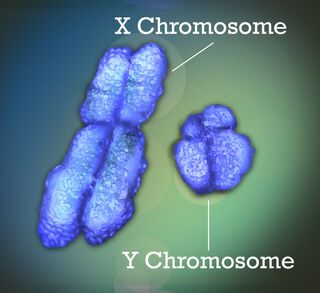Genetics
Is the Female Brain Superior?
Genetics makes female brains more diverse, and everyone benefits.
Posted March 8, 2022 Reviewed by Abigail Fagan
Key points
- Genetic females have two X chromosomes, while genetic males have one X chromosome.
- Having two X chromosomes generates a diversity of cells, especially brain cells.
- The X chromosome carries more genes related to the brain than any of our other 22 chromosomes.
- Genetic diversity in the X chromosome could be a key to understanding how humans developed our unique array of cognitive innovations.

Inside most of your cells, you probably have either two X chromosomes or one X chromosome and one Y chromosome. The former group are genetic females, while the latter are genetic males. Rarely, people have other genetic combinations such as two Xs and a Y. In all genetic combinations, personal expression of gender identity—which is distinct from genetic sex—is endlessly variable.
The Consequences of Having Two X Chromosomes
People with two X chromosomes turn out to have a special capacity for generating a diversity of cells in their bodies, especially brain cells (neurons). This diversity, though still mysterious, could be a key to understanding how humans developed our unique array of cognitive skills and abilities. The diversity of the female brain may make it a kind of laboratory in which key aspects of human innovation have been conceived and tested out.
In terms of genetics, having two X chromosomes poses a potential problem. The purpose of genes is to tell cellular machinery to build certain chemicals at certain times. These chemicals, largely proteins, combine and interact to carry out bodily functions from digestion to daydreaming. The issue with having two X chromosomes is that the genes could potentially produce twice as many chemicals as needed. This would be wasteful, but more importantly, this kind of overproduction can strongly affect development, especially in the brain. For example, Down’s syndrome is caused by an overproduction of gene products in a different chromosome during early embryonic development.
In People With Two Xs, Each Cell Randomly Chooses One X Chromosome to Deactivate
Nature’s solution to this overproduction problem is to deactivate one of the X chromosomes. The process was discovered in the early 1960s by English geneticist Mary Lyon and was termed Lyonization, though she herself disliked the term.
It all starts at conception. A sperm brings a copy of the X chromosome of the father to the mother’s egg, which has a copy of one of her X chromosomes. After some cell divisions, each cell “decides” which of the two X chromosomes to use, and which one to deactivate. The choice is essentially random, but consequential. The X chosen for deactivation crumples into a ball and becomes mostly inert. The cells keep dividing, each time passing along the choice of X chromosome to their daughter cells. The activated X chromosome coordinates the complex dance of gene expression for the rest of each cell's life.
What this means is that genetic females have around twice the genetic diversity in their crucial X chromosomes compared to genetic males, who just have one X chromosome. All across their bodies—and especially in their brains—genetic females have roughly half of their cells relying on their mother’s X chromosome genes and the other half relying on their father’s X genes, all interspersed.
This might seem like a bad idea since conditions like colorblindness are due to faulty genes on the X chromosome. And in fact, cells whose active X is the faulty one do malfunction. Fortunately, the cells that “chose correctly” and activated the working copy of a gene are generally able to compensate for the faulty ones.
X Chromosomes and the Brain
For the brain, the implications of this bizarre biological process of random chromosome deactivation are potentially enormous. The X chromosome carries more genes related to the brain than any of our other 22 chromosomes. Throughout the brain of a genetic female, there is a mosaic of neurons relying on either the mother’s X genes or the father’s X genes. The subtle differences in the two copies of the genes could lead to all manner of differences in function, from the level of single neurons up to whole-brain systems. Because of random variation, it is even possible to have the left hemisphere of the brain activate mostly one X chromosome, and the right hemisphere activate mostly the other X, as has been shown in mouse research.
Geneticists still know very little about the causes and effects of Lyonization. But the increased diversity of X genes in different cells could provide a laboratory for testing out variations in neural function. Cell diversity underpins all of the architecture of computation and communication in the brain. With twice the diversity in X genes, new patterns of connectivity and neuronal response could emerge in the incubator of the female brain, and such innovations could find use in the right time and place.
A faulty X chromosome can still sometimes cause havoc in the female brain, even if the second copy of the chromosome is normal. Fragile X syndrome is related to a mutation on the X chromosome and is the most common cause of inherited intellectual disability. As described in The Carriers, a new book by clinical psychiatrist Anne Skomorowsky, female carriers of this condition, who have one faulty X chromosome, should be protected by their normal second copy of the X. However, they seem to have higher susceptibility to Parkinson's disease, ADHD, mood disorders, and a variety of other conditions. In such cases, cells that chose correctly and activated the working X chromosome may not be able to fully compensate for cells that chose incorrectly.

Diversity and Innovation
The genetic diversity that exists within the female brain is a potential wellspring of creativity and innovation. It may have even shaped the trajectory of our entire species as we moved from hunter-gatherer lifestyles to farming. As anthropologist David Graeber and archaeologist David Wengrow write in their treatise on human innovation The Dawn of Everything, our ancestors’ breakthroughs in the development of agriculture and complex social organization, gained from experimentation with a host of animal, plant, and microbial species, were "accumulated over centuries, largely by women, in an endless series of apparently humble but in fact enormously significant discoveries.” These discoveries “had the cumulative effect of reshaping everyday life every bit as profoundly as the automatic loom or lightbulb." This accumulation of human wisdom could well be related to the genetic diversity of the female brain, though research to directly support this idea is needed.
Mary Lyon died in 2014 but her work on sex chromosomes was long regarded as worthy of a Nobel Prize. It is sadly ironic that in her lifetime, she was passed over in part because of her two X chromosomes. When she completed her undergraduate studies at Cambridge University in the 1940s, she was awarded a lesser degree than her male colleagues, despite completing the same requirements; she was only awarded the full degree in 1998. She also contended with at times unhinged efforts by male scientists to prove her wrong throughout the 1960s. But her hypothesis has ultimately proven correct.
We can’t ascribe Mary Lyon’s individual brilliance to the mosaic of sex chromosomes in her brain. But today, as we celebrate International Women's Day, we can wonder whether the journey to Lyon's discovery began in the brains of her female ancestors.
Copyright © 2022 Daniel Graham. Unauthorized reproduction of any content on this page is forbidden. For reprint requests, email reprints@internetinyourhead.com
Facebook/LinkedIn image: eva_blanco/Shutterstock
References
Graeber, D., & Wengrow, D. (2021). The Dawn of Everything: A new history of humanity. Macmillan.
Skomorowsky, A. 2022. The Carriers. Columbia University Press.
Szelenyi, E. R., Fisenne, D., Knox, J. E., Harris, J. A., Gornet, J. A., Palaniswamy, R., ... & Osten, P. (2018). Brain X chromosome inactivation is not random and can protect from paternally inherited neurodevelopmental disease. Biorxiv.
Wu, H., Luo, J., Yu, H., Rattner, A., Mo, A., Wang, Y., ... & Nathans, J. (2014). Cellular resolution maps of X chromosome inactivation: implications for neural development, function, and disease. Neuron, 81(1), 103-119.
Zimmer, C. (2019). She Has Her Mother's Laugh: The Powers, Perversions, and Potential of Heredity. Penguin.




